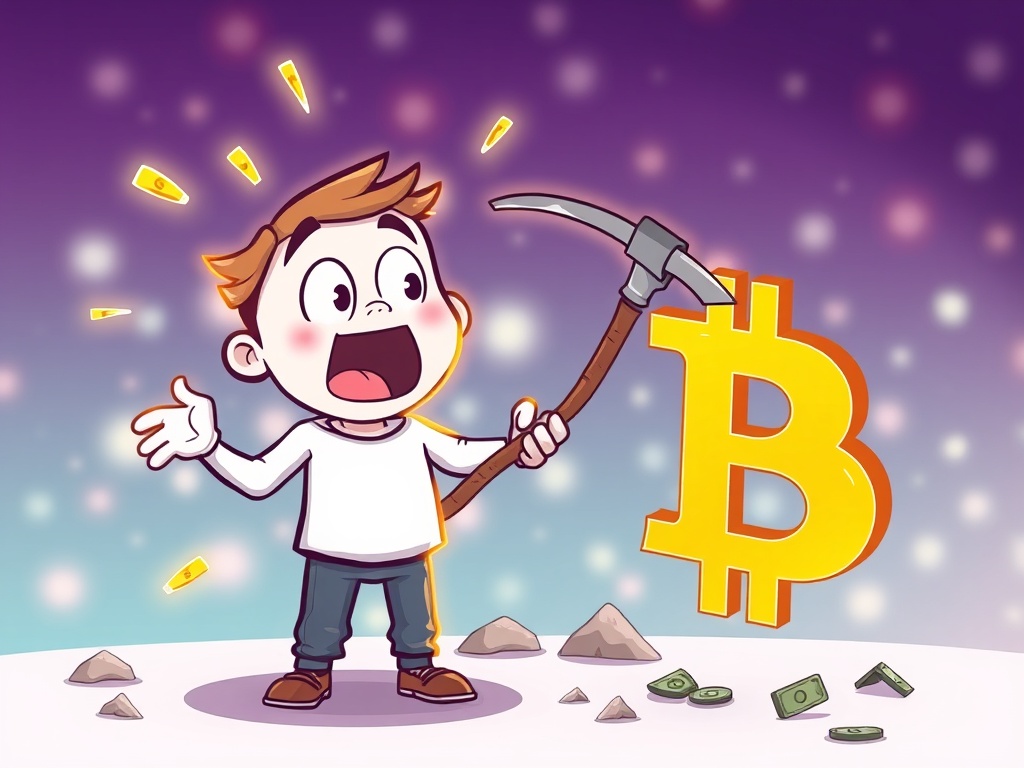Bitcoin Solo Mining: One Miner’s Astonishing $347K Triumph!
0
0

BitcoinWorld

Bitcoin Solo Mining: One Miner’s Astonishing $347K Triumph!
Imagine hitting the jackpot against astronomical odds. That’s precisely what happened to one fortunate individual who achieved a remarkable Bitcoin solo mining triumph recently. This incredible feat saw a single miner successfully find a Bitcoin block, securing a substantial reward of 3.129 BTC, valued at approximately $347,980 at the time of the report by Cointelegraph. This story isn’t just about money; it’s a testament to the unpredictable, yet thrilling, nature of cryptocurrency.
What Exactly is Bitcoin Solo Mining?
At its core, Bitcoin solo mining involves an individual attempting to validate a block of transactions on the Bitcoin blockchain entirely on their own, without joining a mining pool. When a miner successfully validates a block, they are rewarded with newly minted Bitcoins and transaction fees. In a world dominated by large mining farms and pools, going it alone is like buying a single lottery ticket when everyone else is buying millions.
Here’s a quick breakdown:
- Solo Mining: One miner, one chance. They keep the entire block reward if successful.
- Pool Mining: Many miners combine their computational power. Rewards are shared proportionally based on contributions.
The vast majority of Bitcoin mining today occurs in pools because the network’s difficulty is incredibly high. This makes the solo miner’s success exceptionally rare and truly noteworthy.

The Incredible Odds: Why This Bitcoin Solo Mining Feat is So Rare
The probability of a single miner with a modest amount of hash power finding a block is minuscule. Bitcoin’s network difficulty adjusts approximately every two weeks to ensure blocks are found, on average, every ten minutes. As more miners join and computational power increases globally, the difficulty rises. This means a solo miner needs an extraordinary stroke of luck to be the first to solve the complex cryptographic puzzle.
Consider these challenges for Bitcoin solo mining:
- High Hash Rate Requirement: The global hash rate is enormous, requiring immense computational power to compete effectively.
- Electricity Costs: Running powerful mining equipment consumes significant energy, which can quickly outweigh potential earnings without consistent block rewards.
- Hardware Investment: Specialized Application-Specific Integrated Circuit (ASIC) miners are expensive, making the initial investment substantial for solo operations.
This recent success highlights that while the odds are stacked, the possibility, however remote, still exists for the determined individual.
A Glimpse into the Miner’s Journey: How Did They Achieve This Bitcoin Solo Mining Win?
While the specifics of this particular miner’s setup remain private, their success is a testament to perseverance and, undeniably, immense luck. They were likely running a powerful mining rig, dedicating its entire hash power to the solo endeavor. For a solo miner to find a block, their equipment must be running efficiently, constantly searching for the correct hash value that validates the next block.
The reward for this successful block validation was a significant 3.129 BTC. This amount includes the standard block subsidy (currently 3.125 BTC after the recent halving) plus any transaction fees associated with the block. For this individual, it represents a life-changing sum, turning a speculative venture into a lucrative windfall.
Beyond the Block: What Does This Bitcoin Solo Mining Success Mean?
This remarkable event serves as a powerful reminder of Bitcoin’s decentralized nature and the potential for unexpected rewards within the crypto ecosystem. It inspires many, showcasing that even in an industry dominated by institutional players, individual contributions can still lead to monumental outcomes. It reinforces the dream for many enthusiasts who dabble in crypto, proving that the ‘little guy’ can indeed win big.
The story of this successful Bitcoin solo mining effort resonates deeply within the community, sparking conversations about the future of mining and the enduring appeal of Bitcoin. It underscores the unique blend of technology, economics, and chance that defines the world of digital assets.
This rare triumph in Bitcoin solo mining stands as a beacon of hope and a fascinating anomaly in the cryptocurrency landscape. It reminds us that while the odds are long, the potential for extraordinary success remains, captivating the imagination of miners and enthusiasts alike. This single event adds another captivating chapter to Bitcoin’s rich history, demonstrating that sometimes, against all expectations, the solo journey can lead to the greatest rewards.
Frequently Asked Questions (FAQs)
1. How difficult is it to solo mine Bitcoin?
It is extremely difficult. The global Bitcoin network hash rate is immense, meaning a solo miner has a minuscule chance of finding a block compared to joining a mining pool.
2. What is the reward for mining a Bitcoin block?
After the April 2024 halving, the base block reward is 3.125 BTC, plus any transaction fees included in the block. This miner received 3.129 BTC in total.
3. Is solo mining Bitcoin profitable?
For most individuals, solo mining is not profitable due to high electricity costs and the low probability of success. Mining pools offer more consistent, albeit smaller, payouts.
4. What equipment do you need for Bitcoin solo mining?
You need specialized hardware called ASIC (Application-Specific Integrated Circuit) miners, which are designed specifically for Bitcoin mining. These can be expensive and consume significant power.
5. What does ‘halving’ mean in Bitcoin mining?
Halving is a programmed event that cuts the reward for mining new blocks by half. It occurs approximately every four years and reduces the rate at which new Bitcoins are created, contributing to its scarcity.
If this astonishing story of a solo miner’s success has captivated your interest, share it with your friends and fellow crypto enthusiasts on social media! Let’s spread the word about the incredible possibilities within the world of digital assets.
To learn more about the latest Bitcoin mining trends, explore our article on key developments shaping Bitcoin’s price action.
This post Bitcoin Solo Mining: One Miner’s Astonishing $347K Triumph! first appeared on BitcoinWorld and is written by Editorial Team
0
0
 Manage all your crypto, NFT and DeFi from one place
Manage all your crypto, NFT and DeFi from one placeSecurely connect the portfolio you’re using to start.





